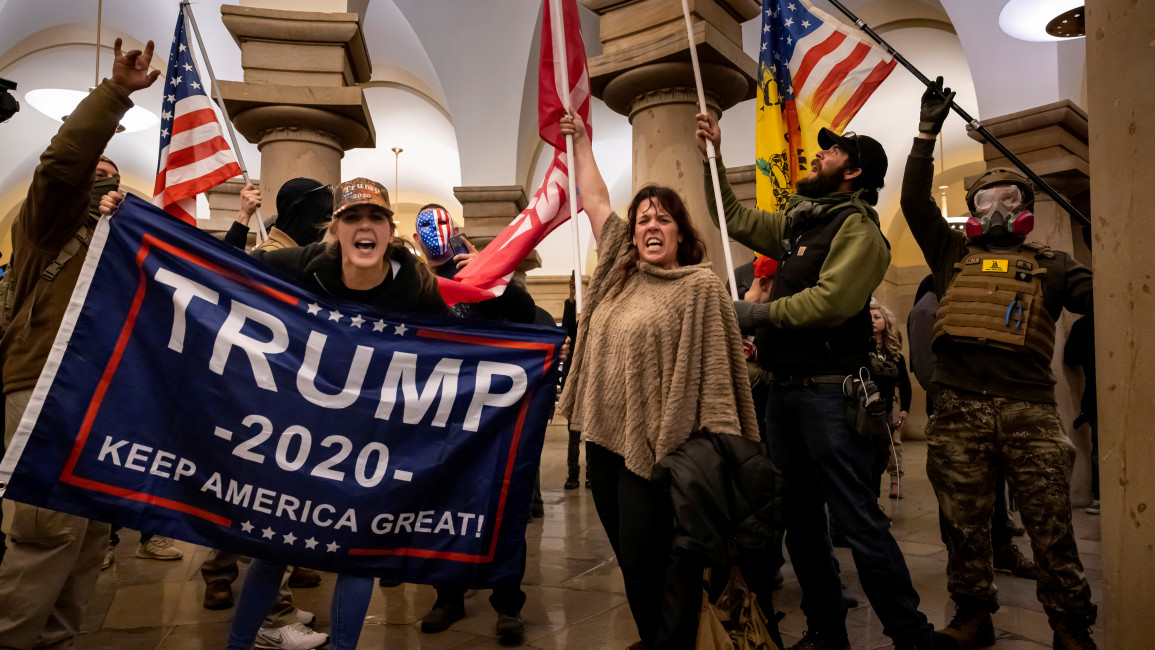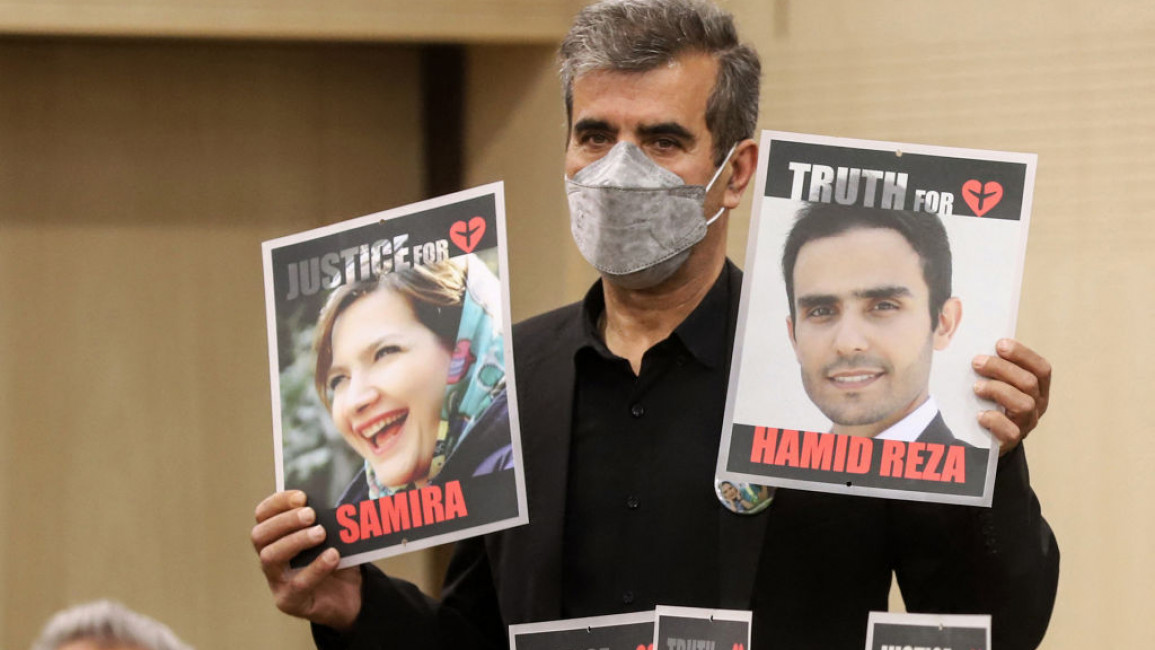Richard Sudan
06 Jan, 2022

Trump supporters breached security and stormed the US Capitol as Congress debated the 2020 presidential election Electoral Vote Certification on January 6, 2021, in Washington, DC.
One year ago, thousands of people stormed the US Capitol, ransacking the very buildings at the heart of US democracy. Regardless of whether white supremacy had previously been embraced, side-lined or denied by Americans, here it was on naked display proudly parading through the streets for the entire world to see.
Black communities have, of course, been terrorised by white supremacy in all its forms for hundreds of years. But it took Jan 6 to pierce the consciousness of many people - and that should not be the case.
The previous year leading up to the Capitol riots had seen a wave of Black Lives Matter protests sweep the country, which eventually spread around the world, leading to calls for the police to be reformed and even defunded. This even reignited calls for African-American descendants of slaves to be allocated reparations to address the longstanding and demonstrably provable racial imbalance in the country.
White supremacists swarming the capitol on Jan 6th was, at least in part, a direct backlash to the growing demands for racial justice for Black people in the United States. While they were encouraged by Trump and other politicians, it is important to remember that white supremacy is not a right or left issue. And the vast array of protesters which took part represented a wide spectrum of American society and professions including law, law enforcement, and the armed forces. A significant portion of that crowd were undoubtedly card-carrying white supremacists.
"Black communities have, of course, been terrorised by white supremacy in all its forms for hundreds of years. But it took Jan 6 to pierce the consciousness of many people - and that should not be the case"
Eventually, several weeks after the Capitol siege, FBI director Christopher Wray acknowledged that Jan 6 constituted an act of domestic terror. Not only that, but the FBI have also admitted that white supremacy is the most significant and growing domestic terror threat on US soil, accounting for the lion’s share of the FBI’s resources.
You might think that for a nation that famously coined the phrase “the war on terror” that the obvious threat of white supremacist extremism within its own borders might lead to a war on white supremacy. But far from this happening, it seems as though white supremacy was the talk of the town for only a few weeks in 2020 - enough time to safely get the openly racist Trump out of office.
Conversations about reparations too, were very popular in the run up to the election, but fizzled out following Biden’s victory. Biden even pledged to meet rapper Ice Cube to discuss reparations and a plan for Black America. This meeting, of course, never transpired.
But one year on, and despite President Biden’s commemoration speech calling for a “new chapter”, there has been an acute failure by the American government to tackle white supremacy, which remains a life or death issue for Black Americans. The conditions that produced the Capitol siege remain in place and wilfully unchallenged. Far from healing any racial divides as some liberal pundits sought to frame the election, the polarisation that characterised the campaigns merely exposed the fragility of it.
The report into the events of Jan 6 is moving at a snail’s pace. While some of the perpetrators have since been jailed, there have been widespread accusations that the sentences handed down by judges have often amounted to little more than slaps on the wrist. While Black and non-white people have been jailed for much longer for much less, those involved in a significant act of domestic terror have not received punishments which reflect the severity and significance of what took place at the Capitol.
Groups like the Proud Boys, Oath Keepers and other white supremacist militia, who played a role in the Capitol riots, have not been added to any US list of domestic terror groups. Canada did make the move, by designating the Proud Boys as such, but the United States has failed to do so. In the United States, the ties between many corrupt police officers and links to white supremacist groups, with many being active members, have been well exposed.
White supremacist violence at Capitol was anything but unprecedented
A solid investigation into the ties of some politicians to the groups that participated in storming the Capitol has been stalled at every juncture. Roger Stone, a former key ally of Donald Trump, was famously pictured with Oath Keeper members thought to have taken part in the riots on the morning of the riots themselves. Stone of course has denied having any prior knowledge of the events which took place later in the day.
There have been suggestions too, that some law enforcement officers not only had prior knowledge of what would take place at the Capitol on Jan 6, but that some actively took part in the violent scenes and encouraged it. One year on and that rabbit hole in particular seems to have been avoided at all costs.
In many ways, much of this is nothing new. The lines between the system, law enforcement and white supremacy are increasingly blurred. White vigilantism in the United States is not only relatively unpunished but is often rewarded, with Kyle Rittenhouse offering a case in point. This in itself sets a very dangerous precedent going into 2022, and it is a precedent that remains unchallenged.
"For America to finally get its house in order, and to tackle the ongoing scourge of racism that blights the nation, it needs to "stop denying racism, and start dismantling it""
The reality is, much like in the UK, the US’s long-standing relationship and systemic love affair with white supremacy runs deep with strong foundations that can’t be removed overnight, even with the political will, however an uncomfortable truth it might be for some.
US Federal authorities have known of the threat to national security that white supremacy poses for decades. Jan 6 was not so much a culmination of the problem, as some like to frame it, but rather symptomatic of a much wider issue- “chickens coming home to roost” if you will.
For America to finally get its house in order, and to tackle the ongoing scourge of racism that blights the nation, it needs to heed the words of the UN High Commission on Human Rights and to “Stop denying racism, and start dismantling it”. It’s not enough to pay lip service to the causes of Jan 6. The conditions which produce it must be eradicated, once and for all.
Richard Sudan is a journalist and writer specialising in anti-racism and has reported on various human rights issues from around the world. His writing has been published by The Guardian, Independent, The Voice and many others.
Opinions expressed in this article remain those of the author and do not necessarily represent those of The New Arab, its editorial board or staff.








